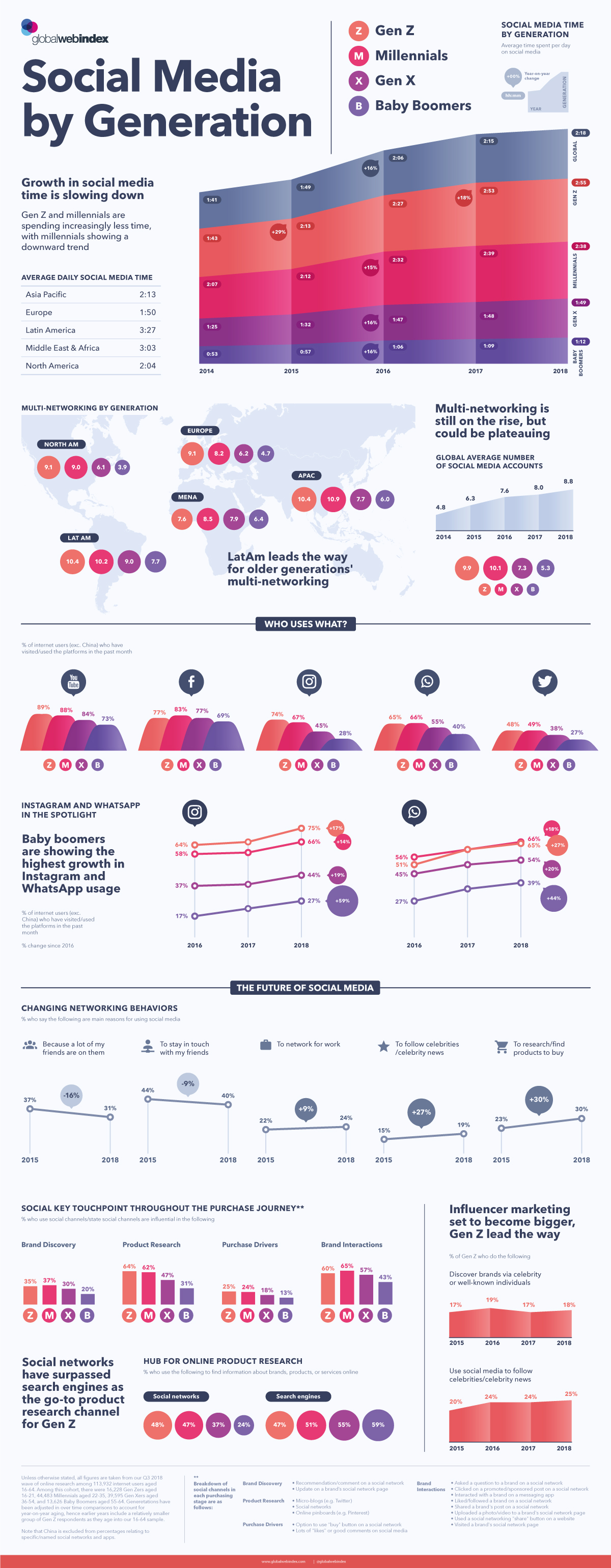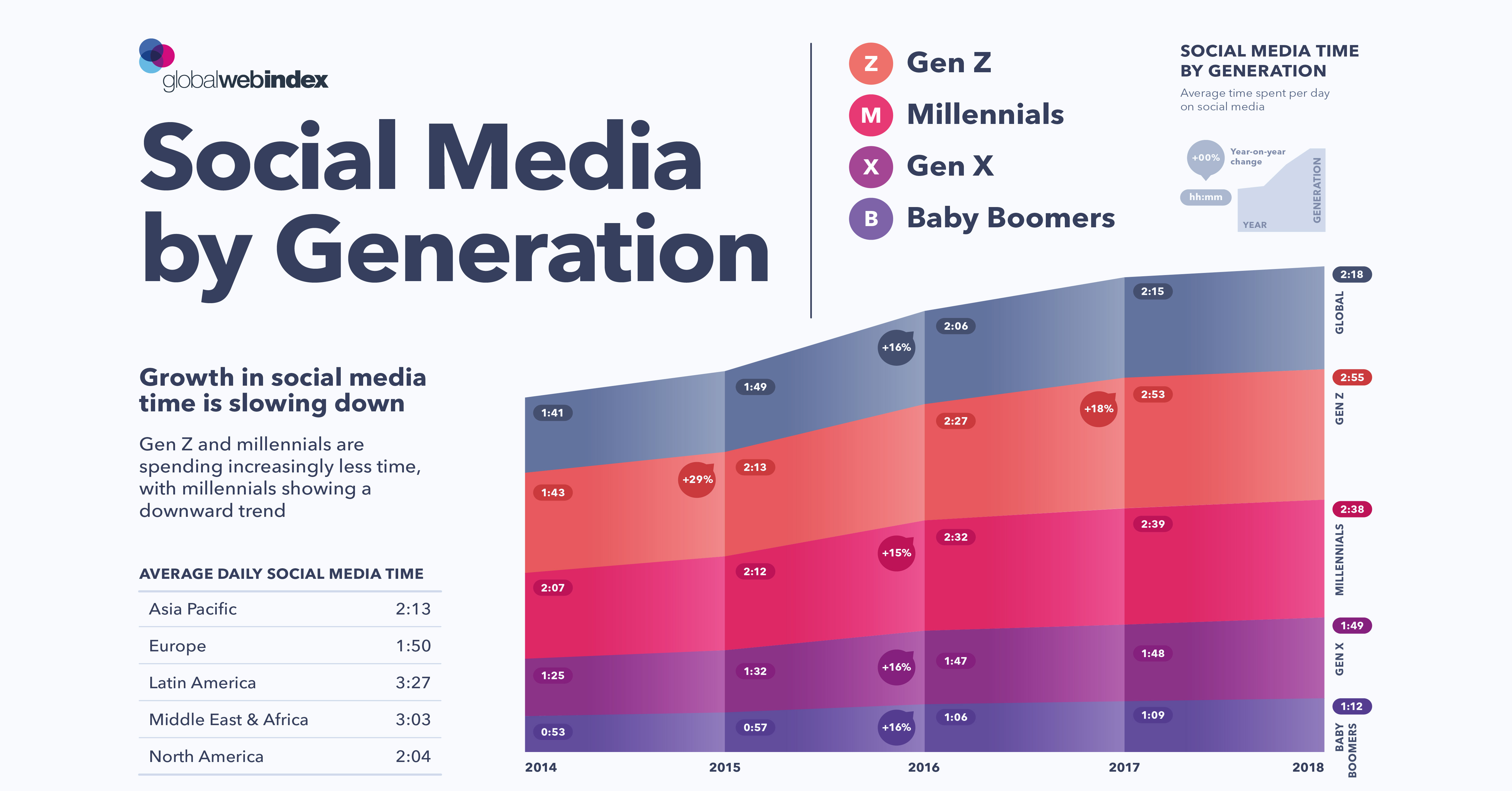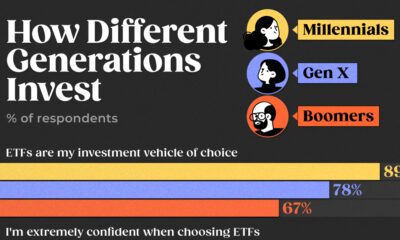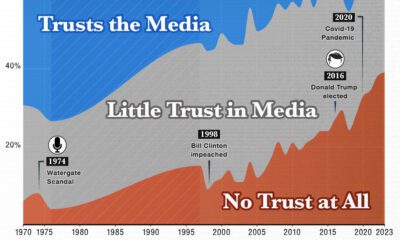Technology
Visualizing Social Media Use by Generation

Visualizing Social Media Use by Generation
Our world has never been more connected than it is today.
Nearly two-thirds of the world’s population is plugged into the matrix, with over 4.4 billion internet users across multiple device types. We use these devices for work and for play—and social media has altered the way we interact both online and offline.
Today’s infographic from Global Web Index compares key generational and regional differences of social media use based on data from nearly 114,000 internet users, highlighting how pervasive social media has become in our lives.
Note: China is excluded from the usage data regarding specific social networks and apps.
From Age to Age: Social Media by Generation
How does the use of social media vary by generation?
Baby Boomers
Boomers currently rank last in nearly every category and metric when it comes to technology and social media use. This generation didn’t grow up inundated with technology in the way today’s youth are.
However, Boomers are showing the greatest increase in activity on social media platforms. For example, usage of Instagram and WhatsApp is up 59% and 44% respectively for this group since 2016, which is more than double the global average.
Generation X
Also known as the ‘MTV Generation’, the Gen X group was the last generation to grow up before the Internet truly took off. The early years of this group were marked by a burst of new technologies, from wireless phones to personal computers.
On average, Gen Xers spend nearly two hours on social media per day—less than Millennials and Gen Z, but more than Boomers.
Millennials
Perhaps surprisingly, Millennials show a slow down in the time spent on social media. From 2017-2018, screen time for Millennials on social media decreased by one minute, to 2 hours 38 minutes per day. This trend points to Millennials seeking real-life experiences and better engagement from the brands they interact with online, rather than passive scrolling.
Other factors also play a role in this evolution─nearly 50% of Millennials admit that their activity on social media has caused them to overspend to impress their networks.
Generation Z
Gen Z is the first group in history that has never known a world without the Internet. Immersed in the online world since birth, Gen Z surpasses Millennials in daily activity on social media with 2 hours 55 minutes spent per day.
North American, Latin American, and European Generation Z-ers lead in the number of social accounts they’re actively using. Many are also moving away from platforms like Facebook in favor of multimedia-heavy sites such as YouTube and Instagram.
Social Media by the Numbers
Social media sites measure the number of unique users on the platform each month as a metric of success. Below is a snapshot of the five major social media sites shown in today’s graphic and their active user count.
Monthly Active Users (MAU) as of July 2019
- Facebook: 2.4 billion
- YouTube: 2 billion
- WhatsApp: 1.6 billion
- Instagram: 1 billion
- Twitter: 330 million
Even more striking is what happens in a social media minute:
- 41.6 million messages sent over Facebook Messenger and WhatsApp
- 347,222 people are scrolling Instagram
- 87,500 people posting to Twitter
- 4.5 million videos on YouTube being watched
Social Media’s Role in Retail
Social media has evolved from simply keeping us connected to our friends. Users can now access career tools, engage with their favorite companies, stay current with global events, and find love.
Across all regions and generations, social media has propelled e-commerce into the limelight. More than ever before, social media sites are being used for product research, brand engagement, and online purchases. For example, Instagram now offers one-click shop features that allow users to buy what they see immediately, with a simple tap on their screens.
The greatest growth in e-commerce, however, has been the influencer industry. These star-studded internet personalities boast massive online followings from a wide range of demographics—and companies are taking notice.
In 2018, 72% of major brands stated that they were outsourcing a significant portion of their marketing resources to online influencers. Followers feel as though they’re getting a product recommendation from a friend, making them more likely to buy quickly.
Social Media Growth
Despite the rate of social media growth slowing down, social media use is still growing. From 2017 to 2018, the average person increased usage by three minutes per day, while becoming a new user of 0.8 social media accounts.
Social media is a broad, multi-faceted, and complex industry that appeals to a wide range of cultures, age groups, and personalities. While growth in social media activity may be slowing down, a growing global population may mean we’ll see more opportunities to stay connected.
Technology
Charting the Next Generation of Internet
In this graphic, Visual Capitalist has partnered with MSCI to explore the potential of satellite internet as the next generation of internet innovation.

Could Tomorrow’s Internet be Streamed from Space?
In 2023, 2.6 billion people could not access the internet. Today, companies worldwide are looking to innovative technology to ensure more people are online at the speed of today’s technology.
Could satellite internet provide the solution?
In collaboration with MSCI, we embarked on a journey to explore whether tomorrow’s internet could be streamed from space.
Satellite Internet’s Potential Customer Base
Millions of people live in rural communities or mobile homes, and many spend much of their lives at sea or have no fixed abode. So, they cannot access the internet simply because the technology is unavailable.
Satellite internet gives these communities access to the internet without requiring a fixed location. Consequently, the volume of people who could get online using satellite internet is significant:
| Area | Potential Subscribers |
|---|---|
| Households Without Internet Access | 600,000,000 |
| RVs | 11,000,000 |
| Recreational Boats | 8,500,000 |
| Ships | 100,000 |
| Commercial Aircraft | 25,000 |
Advances in Satellite Technology
Satellite internet is not a new concept. However, it has only recently been that roadblocks around cost and long turnaround times have been overcome.
NASA’s space shuttle, until it was retired in 2011, was the only reusable means of transporting crew and cargo into orbit. It cost over $1.5 billion and took an average of 252 days to launch and refurbish.
In stark contrast, SpaceX’s Falcon 9 can now launch objects into orbit and maintain them at a fraction of the time and cost, less than 1% of the space shuttle’s cost.
| Average Rocket Turnaround Time | Average Launch/Refurbishment Cost | |
|---|---|---|
| Falcon 9* | 21 days | < $1,000,000 |
| Space Shuttle | 252 days | $1,500,000,000 (approximately) |
Satellites are now deployed 300 miles in low Earth orbit (LEO) rather than 22,000 miles above Earth in Geostationary Orbit (GEO), previously the typical satellite deployment altitude.
What this means for the consumer is that satellite internet streamed from LEO has a latency of 40 ms, which is an optimal internet connection. Especially when compared to the 700 ms stream latency experienced with satellite internet streamed from GEO.
What Would it Take to Build a Satellite Internet?
SpaceX, the private company that operates Starlink, currently has 4,500 satellites. However, the company believes it will require 10 times this number to provide comprehensive satellite internet coverage.
Charting the number of active satellites reveals that, despite the increasing number of active satellites, many more must be launched to create a comprehensive satellite internet.
| Year | Number of Active Satellites |
|---|---|
| 2022 | 6,905 |
| 2021 | 4,800 |
| 2020 | 3,256 |
| 2019 | 2,272 |
| 2018 | 2,027 |
| 2017 | 1,778 |
| 2016 | 1,462 |
| 2015 | 1,364 |
| 2014 | 1,262 |
| 2013 | 1,187 |
Next-Generation Internet Innovation
Innovation is at the heart of the internet’s next generation, and the MSCI Next Generation Innovation Index exposes investors to companies that can take advantage of potentially disruptive technologies like satellite internet.
You can gain exposure to companies advancing access to the internet with four indexes:
- MSCI ACWI IMI Next Generation Internet Innovation Index
- MSCI World IMI Next Generation Internet Innovation 30 Index
- MSCI China All Shares IMI Next Generation Internet Innovation Index
- MSCI China A Onshore IMI Next Generation Internet Innovation Index
MSCI thematic indexes are objective, rules-based, and regularly updated to focus on specific emerging trends that could evolve.

Click here to explore the MSCI thematic indexes

-

 Technology1 week ago
Technology1 week agoCountries With the Highest Rates of Crypto Ownership
While the U.S. is a major market for cryptocurrencies, two countries surpass it in terms of their rates of crypto ownership.
-

 Technology2 weeks ago
Technology2 weeks agoMapped: The Number of AI Startups By Country
Over the past decade, thousands of AI startups have been funded worldwide. See which countries are leading the charge in this map graphic.
-

 Technology3 weeks ago
Technology3 weeks agoAll of the Grants Given by the U.S. CHIPS Act
Intel, TSMC, and more have received billions in subsidies from the U.S. CHIPS Act in 2024.
-

 Technology3 weeks ago
Technology3 weeks agoVisualizing AI Patents by Country
See which countries have been granted the most AI patents each year, from 2012 to 2022.
-

 Technology3 weeks ago
Technology3 weeks agoHow Tech Logos Have Evolved Over Time
From complete overhauls to more subtle tweaks, these tech logos have had quite a journey. Featuring: Google, Apple, and more.
-

 AI1 month ago
AI1 month agoRanked: Semiconductor Companies by Industry Revenue Share
Nvidia is coming for Intel’s crown. Samsung is losing ground. AI is transforming the space. We break down revenue for semiconductor companies.
-

 Technology1 week ago
Technology1 week agoCountries With the Highest Rates of Crypto Ownership
-

 Mining6 days ago
Mining6 days agoVisualizing Copper Production by Country in 2023
-

 Politics7 days ago
Politics7 days agoCharted: How Americans Feel About Federal Government Agencies
-

 Healthcare1 week ago
Healthcare1 week agoWhich Countries Have the Highest Infant Mortality Rates?
-

 Demographics1 week ago
Demographics1 week agoMapped: U.S. Immigrants by Region
-

 Economy1 week ago
Economy1 week agoMapped: Southeast Asia’s GDP Per Capita, by Country
-

 Automotive1 week ago
Automotive1 week agoHow People Get Around in America, Europe, and Asia
-

 Personal Finance1 week ago
Personal Finance1 week agoVisualizing the Tax Burden of Every U.S. State
















